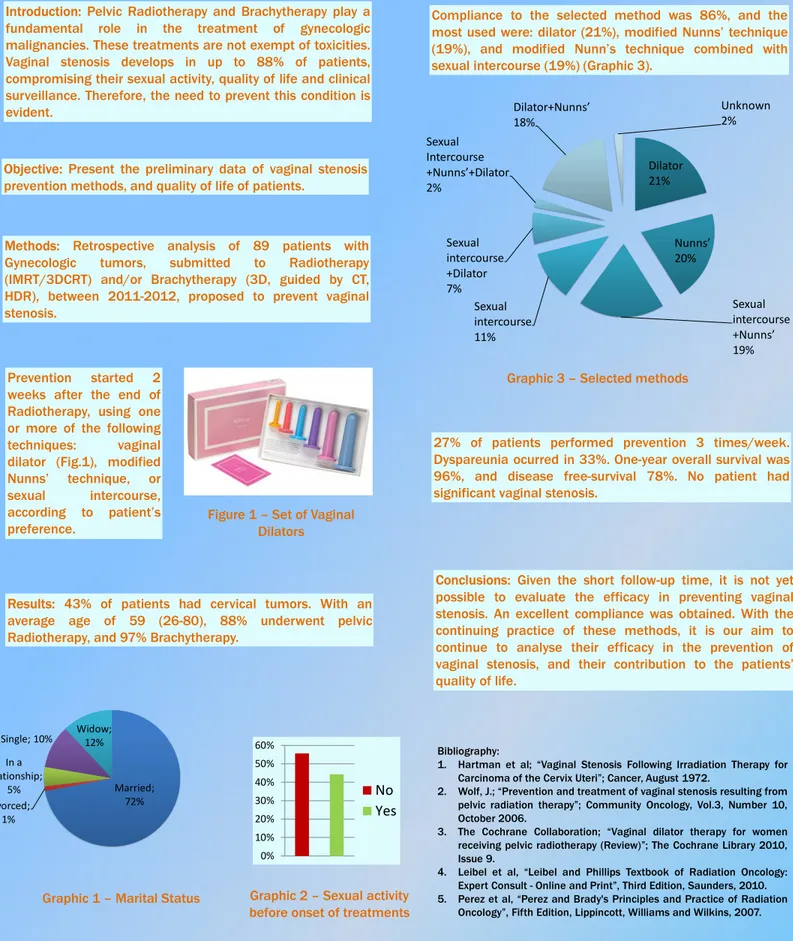Introduction: Pelvic Radiotherapy and Brachytherapy play a fundamental role in the treatment of gynecologic malignancies. These treatments are not exempt of toxicities. Vaginal stenosis develops in up to 88% of patients, compromising their sexual activity, quality of life and clinical surveillance. Therefore, the need to prevent this condition is evident.
Pimenta, Ana 1; Leite, Rita 1; Mota, António1; Fortunato. Maria 1; Guiomar, Teresa1; Santos, Filomena1; Alves, Vânia1; Guedes, Filipe1; Roldão, Margarida 1 1Serviço de Radioterapia, Instituto Português de Oncologia de Lisboa Francisco Gentil.
Objective: Present the preliminary data of vaginal stenosis prevention methods, and quality of life of patients.
Methods: Retrospective analysis of 89 patients with Gynecologic tumors, submitted to Radiotherapy (IMRT/3DCRT) and/or Brachytherapy (3D, guided by CT, HDR), between 2011-2012, proposed to prevent vaginal stenosis.
Compliance to the selected method was 86%, and the most used were: dilator (21%), modified Nunns’ technique (19%), and modified Nunn’s technique combined with sexual intercourse (19%) (Graphic 3).
Conclusions: Given the short follow-up time, it is not yet possible to evaluate the efficacy in preventing vaginal stenosis. An excellent compliance was obtained. With the continuing practice of these methods, it is our aim to continue to analyse their efficacy in the prevention of vaginal stenosis, and their contribution to the patients’ quality of life.
Bibliography:
1. Hartman et al; “Vaginal Stenosis Following Irradiation Therapy for Carcinoma of the Cervix Uteri”; Cancer, August 1972.
2. Wolf, J.; “Prevention and treatment of vaginal stenosis resulting from pelvic radiation therapy”; Community Oncology, Vol.3, Number 10, October 2006.
3. The Cochrane Collaboration; “Vaginal dilator therapy for women receiving pelvic radiotherapy (Review)”; The Cochrane Library 2010, Issue 9.
4. Leibel et al, “Leibel and Phillips Textbook of Radiation Oncology: Expert Consult - Online and Print”, Third Edition, Saunders, 2010. 5. Perez et al, “Perez and Brady's Principles and Practice of Radiation
Oncology”, Fifth Edition, Lippincott, Williams and Wilkins, 2007.
Prevention of vaginal stenosis and quality of life in women
submitted to pelvic Radiotherapy and Brachytherapy –
preliminary results.
Married; 72% Divorced; 1% In a relationship; 5% Single; 10% Widow; 12%Figure 1 – Set of Vaginal Dilators
Prevention started 2 weeks after the end of Radiotherapy, using one or more of the following techniques: vaginal dilator (Fig.1), modified Nunns’ technique, or sexual intercourse, according to patient’s preference.
Graphic 1 – Marital Status
0% 10% 20% 30% 40% 50% 60% No Yes
Graphic 2 – Sexual activity before onset of treatments Results: 43% of patients had cervical tumors. With an average age of 59 (26-80), 88% underwent pelvic Radiotherapy, and 97% Brachytherapy.
Dilator 21% Nunns’ 20% Sexual intercourse +Nunns’ 19% Sexual intercourse 11% Sexual intercourse +Dilator 7% Sexual Intercourse +Nunns’+Dilator 2% Dilator+Nunns’ 18% Unknown 2%
27% of patients performed prevention 3 times/week. Dyspareunia ocurred in 33%. One-year overall survival was 96%, and disease free-survival 78%. No patient had significant vaginal stenosis.
